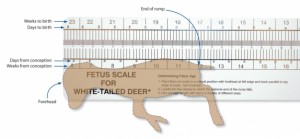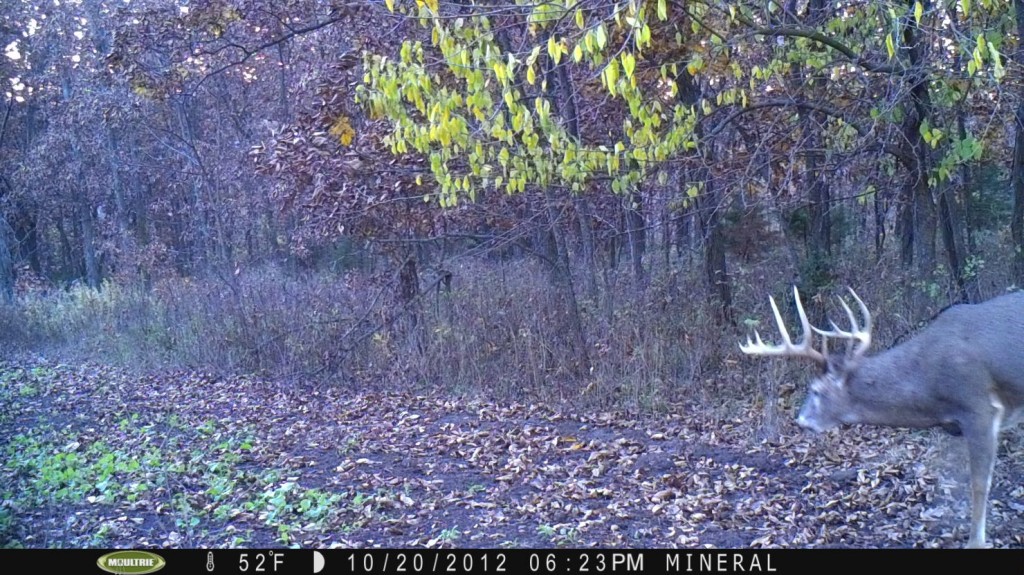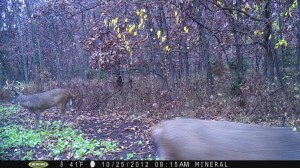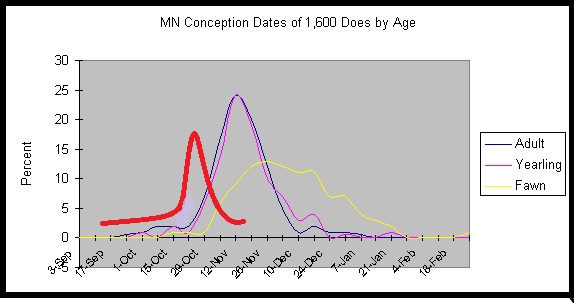Best Two Weeks for Hunting Whitetail
When asked “what is the best time to hunt mature deer”?, my answer is usually whenever you can…but if you only have a week or two to hunt you might want to read on and consider my opinions.
I used to work in a maintenance shop with about 20 other electricians and instrument mechanics. About half of us were avid bow hunters. Each year in the spring we picked that year’s vacations. It was limited to how many people could be off any given week so prime archery weeks were almost always filled in first. Without fail, the calendar weeks that occupied the first two weeks of November were selected first. Then it was usually the later weeks in November…followed by the last weeks in October. It was pretty clear the demand for those two golden weeks in November was at a premium.
When I started my outfitting service, without doubt the most asked for and inquired about time was again those first two weeks of November. I won’t debate that those are good weeks. There was a time when I only had a couple weeks of vacation each year and if I could I always picked that time frame as well. This is the peak of the rut right? When the does are in heat is the time to be in the woods as well right? Well, I said I wouldn’t debate that those first two weeks are good weeks to be in the woods….but I will debate or at least provide another view on why I don’t think they are the best.
Until I got more vacation I never got to hunt any part of the season very hard. Sure I would hunt in September, as much as I could in October, and even again in December. But the lion share of my time spent in the woods was in early November. When I started getting more vacation and thus more time to hunt, I realized that I was missing some pretty good hunting. It became obvious to me in short order that those first two weeks of November had some solid competition. Let me try to explain why!
For purposes of this article I must be upfront and say that I don’t buy into all the rut timing theories out there. I just don’t. I just think that in too many cases outdoor writers and deer hunting show producers run out of material. I prefer to stick with pretty sound math.
State DNR offices can calculate with striking accuracy the “peak” breeding dates. By peak I mean when a deer gets bread and becomes pregnant. They do this either by measuring fawn size of car killed doe for example and predicting when she got bread; or by simply documenting fawn birth dates and going back the 200 day gestation period to accurately determine the breeding dates (you can actually do this yourself if you see a newborn fawn). Year in and year out, these dates simply don’t change all that much.

This is what a fetus scale looks like offered for purchase by QDMA.
Maybe a day or two year to year. The other thing is this…when they plot out their findings on a graph you can quite easily see that actual breeding is in fact a peak. The level of actual breeding sharply increases and decreases before and after this “peak”. If you really hone in on that sharp incline and decline it is my opinion (based on the graph) that the bulk of all doe get bread in about a 10 day window each year during relatively the same time. So state by state if the data is available you can see when the peak breeding 10 day window is. Here’s where the math stops and my opinions start.
When I only had a week or two of vacation and thus took those first two of November off, my hunting always started out pretty good and on average got worse as vacation went on. I would see pretty consistent rutting behavior and movement going into my hunts and more sporadic bursts of movement as I got into November. As a group, the early days of November saw bucks chasing and putting on some ground. Later on with what I realize now coincides with that 10 day window our sightings of mature bucks were limited to you either had a hot doe by you or you didn’t. And having a hot doe by you wasn’t always an easy task. Sometimes during that 10 day window hunting was very tough.

For some reason, every year around October 20th I start to see mature bucks both while hunting and on my cameras during daylight hours. A few days later peak hunting starts to kick in! This is my favorite time of year to hunt. Photo taken on an interior food plot.
When I started taking more time off for hunting, it became pretty clear at least to me that outside that 10 day window was unmistakably the best time to hunt. It kind of worked like this…as a very small number of does would start coming into heat during that mid-October time frame, the daytime activity of mature bucks would start to increase as well. On occasion we would actually witness a hot doe say around October 20th and from that point on the activity and sightings would start to increase and get more consistent.
The activity would ramp up pretty quickly during the next 5 days or so and pretty much every year by October 25th mature bucks (and all the rest as well) would really start to put on some miles. Our cameras would start to light up, sightings themselves would increase, and rutting sign like scraping and rubbing was escalated and more vigorous. In short, the hunting got very good.

October 25th is the start of what I call peak hunting. Every year by the 25th mature bucks are on their feet and can show up during daylight hours.
This fever pitch action and great hunting seemed to last every year for about 2 weeks and then started to taper off. As November 10th or so was reached, the activity seemed to still be there, but it was more sporadic and more contained. I believe this later period is when the bulk of doe were in heat and getting bread…meaning bucks were not traveling as much searching for hot does and when they did find one there movements were restricted to her movements. Hunting got very unpredictable and sometimes very tough.
I didn’t witness this scenario play out just one or two years. It repeated itself over and over. In fact, the vast majority of the mature bucks I have taken over the years were on the ground by the end of October or very early part of November.
The Details
It’s unnecessary to list each state or geographical region’s peak breeding date. You can simply do a Google search for your state’s breeding dates if you wish. Across the Midwest all the way into the Northeast the dates are pretty close (southern states can be different). I’ve seen data that puts peak breeding in these states from Nov. 10th to the 20th with the majority falling around that mid-November or 15th time frame. When you take out that 10 day breeding window what you have is an approximate 2 week window of great action beginning every year around October 25th and going until around November 10th or so. From my experience peak hunting is around Halloween or November 1st almost every year! And the years it’s off a tad are based on weather and nothing more.

This graph depicts the breeding dates of Minnesota which is pretty typical throughout the mid-west and up through the north-east. I inserted the red line which illustrates what I consider Peak Hunting…which steadily ramps up until about October 25 or so each year and then skyrockets. The peak of action year in and year out for me has always been right around Halloween. I think this is because bucks are as ready as they are ever going to get to breed, they are pent up and looking for any available doe. But with only a few doe coming into heat their activity is at a fever pitch!!!
And one final thought although it’s not about the breeding dates or peak of anything…The earlier you hunt the more mature bucks you have to hunt. How is this possible? Very simply as the season progresses deer will get shot and the longer the season goes on the better the chances that one then two or three mature deer get harvested in your area. Unless you have thousands of acres of land to yourself where nobody else can hunt…well if you have that you don’t need to be reading this article now do you!
